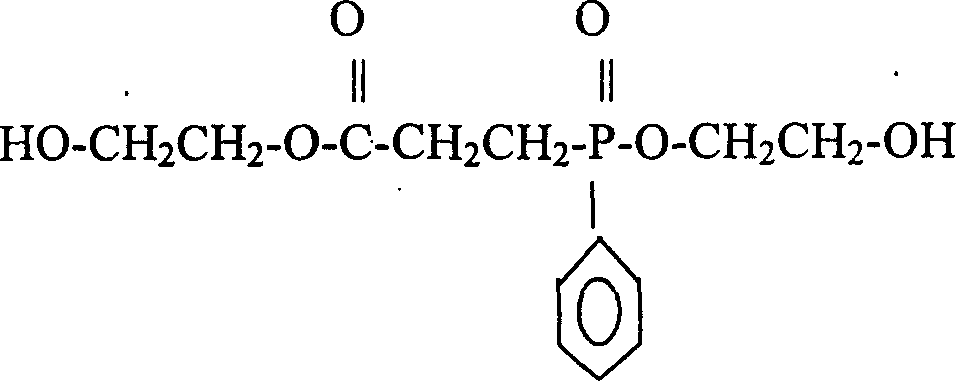Method for preparing flame-resisting polyester in phosphorus series
A manufacturing method and a flame-retardant technology, which are applied in the field of polymer synthesis of halogen-free flame-retardant polymer new materials, can solve the problems of many types of raw materials, many reaction steps, long process routes, etc., and achieve less types of raw materials, low cost, The effect of short process routes
- Summary
- Abstract
- Description
- Claims
- Application Information
AI Technical Summary
Problems solved by technology
Method used
Image
Examples
Embodiment 1
[0026] 1. The first step is to prepare a mixture of ethylene glycol propionate-based phenylphosphate, 2-carboxyethylphenylphosphoric acid and ethylene glycol flame retardant:
[0027] Take 45kg of commercially available 2-carboxyethylphenylphosphoric acid containing 14.5% of phosphorus and 2% of water, and 55kg of ethylene glycol, and add them to the esterification kettle, and gradually raise the temperature to 165°C under stirring, and carry out under normal pressure conditions. Esterification reaction, properly increase the reaction temperature to 170°C before the end of the esterification, collect the distilled water to reach 7.6kg, take the reaction product to measure the acid value to control and determine the desired reaction end point, the esterification rate is 90%, filter for later use . The product is a mixture of ethylene glycol propionate-based phenylphosphate, 2-carboxyethylphenylphosphoric acid and ethylene glycol flame retardant, which contains ethylene glycol p...
Embodiment 2
[0031] 1. The first step is to prepare a mixed solution of ethylene glycol propionate-based phenylphosphate, 2-carboxyethylphenylphosphoric acid and ethylene glycol flame retardant: the method is the same as in Example 1.
[0032] 2. The second step, polymerization of flame retardant polyester:
[0033] Get 200kg of purified terephthalic acid (PTA), 185kg of ethylene glycol (EG), the esterification process conditions and operation method are the same as in Example 1, after the esterification product is moved into the polycondensation tank, add the flame retardant made in the first step and mix Liquid 20kg (wherein contains EG6.9kg) in the polymerizer, catalyzer, auxiliary agent add-on, polycondensation process condition and operating method are with embodiment 1, obtain the required flame retardant polyester chip of the present invention. The phosphorus content in the flame-retardant polyester chip was 5560 ppm.
Embodiment 3
[0035] 1. The first step is to prepare the mixture of ethylene glycol propionate-based phenylphosphate, 2-carboxyethylphenylphosphoric acid and ethylene glycol flame retardant: take commercially available 2% phosphorus containing 14.5% and 2% water - 45kg of carboxyethylphenylphosphoric acid and 55kg of ethylene glycol are added to the esterification kettle, and the temperature is gradually raised to 165°C under stirring, and the esterification reaction is carried out under normal pressure conditions. 170°C, collect the distilled water to reach 6.1kg, take the reaction product to measure the acid value to control and determine the desired reaction end point, the esterification rate is 70%, and filter for later use. The product is a mixture of ethylene glycol propionate-based phenylphosphate, 2-carboxyethylphenylphosphoric acid and ethylene glycol, which contains ethylene glycol propionate-based phenylphosphate 46.4%, 2 -Carboxyethylphenylphosphoric acid 14.1%, ethylene glycol ...
PUM
| Property | Measurement | Unit |
|---|---|---|
| oxygen index | aaaaa | aaaaa |
Abstract
Description
Claims
Application Information
 Login to View More
Login to View More - R&D Engineer
- R&D Manager
- IP Professional
- Industry Leading Data Capabilities
- Powerful AI technology
- Patent DNA Extraction
Browse by: Latest US Patents, China's latest patents, Technical Efficacy Thesaurus, Application Domain, Technology Topic, Popular Technical Reports.
© 2024 PatSnap. All rights reserved.Legal|Privacy policy|Modern Slavery Act Transparency Statement|Sitemap|About US| Contact US: help@patsnap.com









